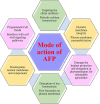Fungal Infections as an Uprising Threat to Human Health: Chemosensitization of Fungal Pathogens With AFP From Aspergillus giganteus
- PMID: 35694549
- PMCID: PMC9174459
- DOI: 10.3389/fcimb.2022.887971
Fungal Infections as an Uprising Threat to Human Health: Chemosensitization of Fungal Pathogens With AFP From Aspergillus giganteus
Abstract
Occurrence and intensity of systemic invasive fungal infections have significantly risen in recent decades with large amount of mortality and morbidity rates at global level. Treatment therapy lies on the current antifungal interventions and are often limited due to the emergence of resistance to antifungal agents. Chemosensitization of fungal strains to the conventional antimycotic drugs are of growing concern. Current antifungal drugs often have been reported with poor activity and side effects to the host and have a few number of targets to manifest their efficacy on the pathogens. Indiscriminately, the aforementioned issues have been easily resolved by the development of new intervention strategies. One such approach is to employ combinational therapy that has exhibited a great level of inhibitions than that of a single compound. Chemosensitization of pathogenic mycoses to commercial antifungal drugs could be drastically enhanced by co-application of chemosensitizers along with the conventional drugs. Chemosensitizers could address the resistance mechanisms evolved in the pathogenic fungi and targeting the system to make the organism susceptible to commercially and clinically proven antifungal drugs. However, this strategy has not been overreached to the greater level, but it needs much attention to fight against not only with the pathogen but combat the resistance mechanisms of pathogens to drugs. Natural compounds including plant compounds and microbial proteins act as potential chemosensitizers to break the resistance in mycoses. Aspergillus giganteus, a filamentous fungus, is known to produce a cysteine rich extracellular protein called as antifungal protein (AFP). AFP has shown enhanced efficacy against several filamentous and non-filamentous fungal pathogens. On the basis of the reported studies on its targeted potential against pathogenic mycoses, AFP would be fabricated as a good chemosensitizer to augment the fungicidal efficacy of commercial antimycotic drugs. This paper reviews on breakthrough in the discovery of antifungal drugs along with the resistance patterns of mycoses to commercial drugs followed by the current intervention strategies applied to augment the fungicidal potential of drugs.
Keywords: AFP; Aspergillus giganteus; antifungal drugs; augmentation; chemosensitization; fungicidal activity; natural compounds.
Copyright © 2022 Dhandapani, Sivarajan, Ravindhiran and Sekar.
Conflict of interest statement
The authors declare that the research was conducted in the absence of any commercial or financial relationships that could be construed as a potential conflict of interest.
Figures





Similar articles
-
Antifungal activity of redox-active benzaldehydes that target cellular antioxidation.Ann Clin Microbiol Antimicrob. 2011 May 31;10:23. doi: 10.1186/1476-0711-10-23. Ann Clin Microbiol Antimicrob. 2011. PMID: 21627838 Free PMC article.
-
A small protein that fights fungi: AFP as a new promising antifungal agent of biotechnological value.Appl Microbiol Biotechnol. 2008 Feb;78(1):17-28. doi: 10.1007/s00253-007-1291-3. Epub 2007 Dec 8. Appl Microbiol Biotechnol. 2008. PMID: 18066545 Review.
-
A Computational Modeling Approach Predicts Interaction of the Antifungal Protein AFP from Aspergillus giganteus with Fungal Membranes via Its γ-Core Motif.mSphere. 2018 Oct 3;3(5):e00377-18. doi: 10.1128/mSphere.00377-18. mSphere. 2018. PMID: 30282755 Free PMC article.
-
Toxoflavin Produced by Burkholderia gladioli from Lycoris aurea Is a New Broad-Spectrum Fungicide.Appl Environ Microbiol. 2019 Apr 18;85(9):e00106-19. doi: 10.1128/AEM.00106-19. Print 2019 May 1. Appl Environ Microbiol. 2019. PMID: 30824447 Free PMC article.
-
Antifungals discovery: an insight into new strategies to combat antifungal resistance.Lett Appl Microbiol. 2018 Jan;66(1):2-13. doi: 10.1111/lam.12820. Epub 2017 Dec 11. Lett Appl Microbiol. 2018. PMID: 29112282 Review.
Cited by
-
Exploring the frontiers of therapeutic breadth of antifungal peptides: A new avenue in antifungal drugs.J Ind Microbiol Biotechnol. 2024 Jan 9;51:kuae018. doi: 10.1093/jimb/kuae018. J Ind Microbiol Biotechnol. 2024. PMID: 38710584 Free PMC article. Review.
-
Bioactivity profile of dissolved organic matter and its relation to molecular composition.Nat Prod Bioprospect. 2023 Sep 18;13(1):32. doi: 10.1007/s13659-023-00395-y. Nat Prod Bioprospect. 2023. PMID: 37721596 Free PMC article.
-
Polyene-Based Derivatives with Antifungal Activities.Pharmaceutics. 2024 Aug 14;16(8):1065. doi: 10.3390/pharmaceutics16081065. Pharmaceutics. 2024. PMID: 39204411 Free PMC article. Review.
References
-
- Barakat H., Spielvogel A., Hassan M., El-Desouky A., El-Mansy H., Rath F., et al. . (2010). The Antifungal Protein AFP From Aspergillus Giganteus Prevents Secondary Growth of Different Fusarium Species on Barley. Appl. Microbiol. Biotechnol. 87 (2), 617–624. doi: 10.1007/s00253-010-2508-4 - DOI - PubMed
Publication types
MeSH terms
Substances
Supplementary concepts
LinkOut - more resources
Full Text Sources
Medical

